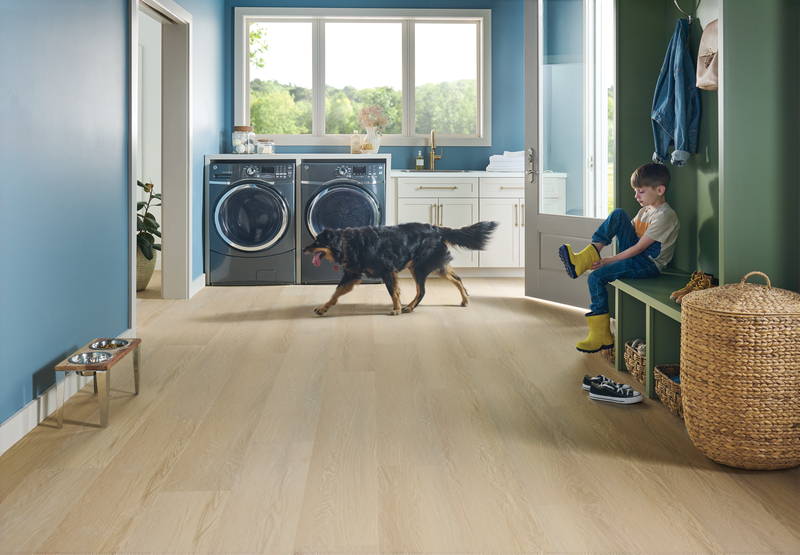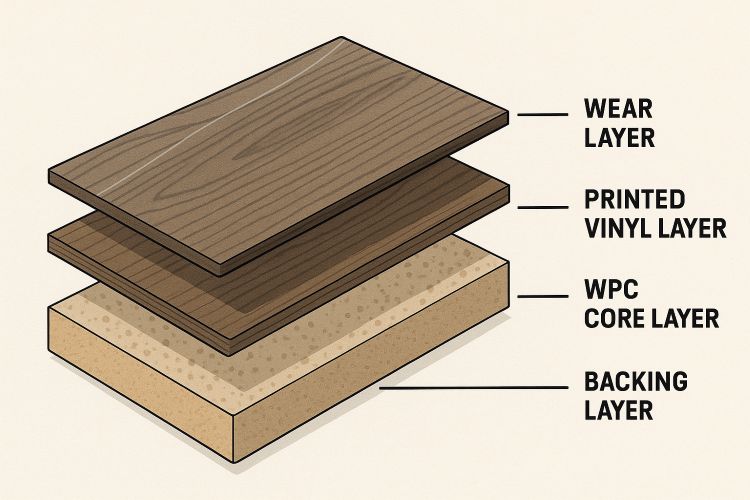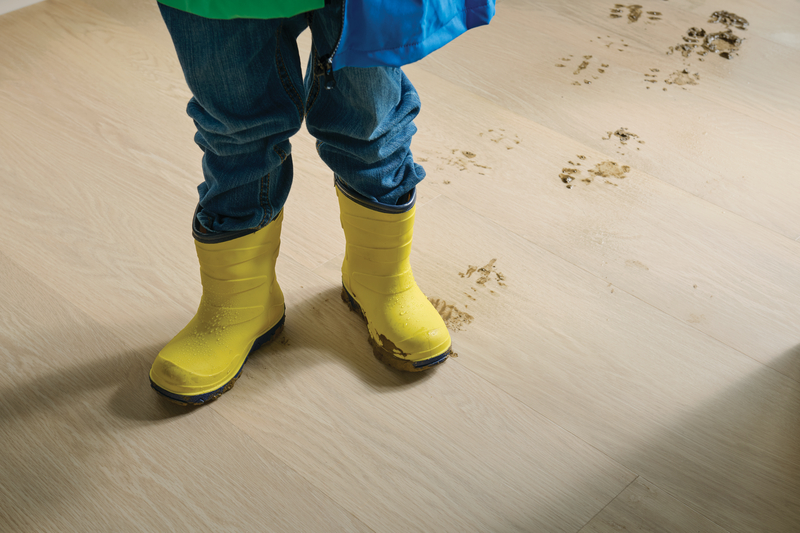WPC Flooring – A Comprehensive Guide for Homeowners
Wood polymer composite flooring, also known as WPC, is a popular choice today. It offers numerous benefits, including durability, scratch resistance, waterproofing, and eco-friendliness.

What is WPC Flooring?
Wood Polymer Composite (WPC) combines the strength of hardwood with the resilience of plastic. It blends natural wood fibers with plastic polymers to produce a sturdy, waterproof core.
WPC flooring has the natural look of solid hardwood flooring but surpasses it in terms of water resistance. The flooring is also more budget-friendly, starting at only $4 per square foot.
What is the Construction of WPC Flooring?
Like luxury vinyl plank flooring, WPC uses multiple layers, each contributing specific characteristics to the final product. Here’s a detailed look at the typical construction layers from bottom to top:

1. Backing Layer
The base or backing layer is the bottom-most part of WPC flooring. Its primary function is to stabilize the plank and ensure it lies flat against the subfloor. This layer often includes an attached underlayment made from cork or foam.
The attached pad (underlayment) can offer additional benefits, such as sound dampening and a softer feel underfoot. It also helps with moisture protection, especially when installed over concrete or other hard surfaces.
2. WPC Core Layer
The heart of the flooring is the wood polymer composite core, which consists of wood fibers or wood flour. It combines with thermoplastics, such as PVC, and other additives, including foaming agents, binders, UV stabilizers, and colorants.
This layer is responsible for most of the floor’s properties, including its durability, water resistance, and rigidity. Despite being waterproof, the WPC core remains slightly flexible. Therefore, WPC is more comfortable underfoot than harder materials, such as rigid core, tile, stone, or ceramic.
3. Printed Vinyl Layer
Above the core is the printed vinyl layer, which gives the flooring incredible realism. The print layer uses a high-definition photographic image printed onto a vinyl sheet.
It allows WPC to mimic various natural materials, including wood, stone, and tile types.
4. Wear Layer
The topmost layer is the wear layer, a clear coating of durable materials such as urethane. It protects the floor from the rigors of daily use, including scratches, stains, and fading.
The thickness of the wear layer varies but is a critical factor in determining the flooring’s durability and longevity. Higher-quality WPC flooring options often feature thicker wear layers for enhanced protection.
This multi-layer construction combines the aesthetics of natural wood with the practical benefits of vinyl and composite materials.
What is the Difference Between WPC and SPC Flooring?
SPC and WPC floors are each part of the rigid core luxury vinyl family. To understand the difference, refer only to the first initial in their names.
The “w” refers to wood, while the “s” refers to stone. So, stone-polymer composite (SPC) flooring uses a mixture of limestone and plastic polymers in its core.
The stone makes SPC flooring denser, harder, and more impact-resistant.
As noted, WPC flooring uses wood as its core to create a softer, more comfortable feel underfoot. It also offers better insulation. If you prefer rigid core luxury vinyl flooring, consider the wood composite option for your home.
If you’re wondering, luxury vinyl tile (LVT) flooring is similar to WPC and SPC flooring. However, it has a vinyl core, which makes it thinner and more flexible.
Does WPC Need Underlayment?
WPC flooring options come with an attached pad. That pad adds sound insulation and helps to smooth out uneven subfloors. This feature makes the installation process quicker and easier.
How Long Do WPC Floors Last?
With proper care and maintenance, WPC floors can last 20 to 25 years or more. Pay attention to the overall thickness and thickness of the wear layer—both contribute to a longer-lasting floor.
Typically, WPC floors are 4mm to 12mm thick, including all flooring layers.
Some companies, like Robbins®, include a lifetime residential warranty with their WPC floors. Horizon’s Embrace™ WPC flooring is available in six colors, including three that are embossed in register, providing a more realistic wood look and feel.

What are the Advantages of WPC Flooring?
Wood polymer composite flooring offers several compelling advantages, making it a favored choice among homeowners and commercial property owners alike:
- Waterproof: WPC’s core composition makes it inherently 100% waterproof. So, unlike solid hardwoods, you can install it in moisture-prone areas without the risk of damage.
- Durability: WPC can withstand heavy foot traffic and resist scratches and dents. Wood-polymer composite flooring is the perfect solution for an active household with pets or kids. It’s softer on the foot than other rigid core products.
- Easy Installation: WPC flooring generally has a click-lock installation system (think DIY). This makes it easy to install over existing flooring without the need for adhesives. You can install it over any hard surface, even if the surface is imperfect or uneven.
- Comfort: WPC’s thicker core provides a softer feel underfoot than flooring like porcelain tile.
- Aesthetic Appeal: With advanced print manufacturing technology known as embossed in register, WPC flooring can replicate the authentic look and feel of natural wood, featuring a surface texture that mimics the real thing. A variety of designs in multiple colors and styles are available to suit any décor.
- Low Maintenance: WPC floors are easy to clean and maintain. Regular sweeping and occasional vacuuming or mopping can keep them looking new for decades.
How Much Does WPC Cost?
Most people consider WPC flooring a mid-range option. It tends to be more expensive than standard luxury vinyl tile (LVT). However, it’s typically less costly than natural wood flooring.
Costs can vary significantly based on the product’s thickness, wear layer, and quality. However, you can expect to pay anywhere from $2 to $7 per square foot, excluding installation costs. Compare that to hardwood, typically costing $6 to $12 per square foot.
Look to Robbins® for Your Flooring
WPC, solid and engineered hardwood, —Robbins carries today’s popular flooring solutions. Our products are available at flooring dealers throughout the U.S.
Before visiting a dealer, use our flooring visualizer to narrow your selection. Just take a picture of your room and select a product. The tool allows you to preview how it will look. Avoid the guesswork to find the perfect solution for your home.
